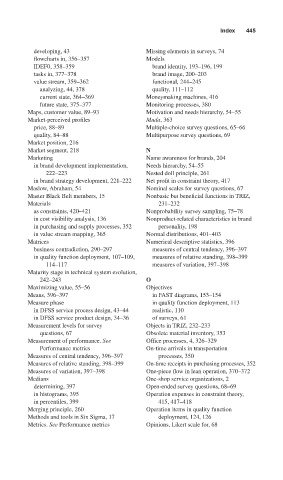Page 487 - Design for Six Sigma for Service (Six SIGMA Operational Methods)
P. 487
Index 445
developing, 43 Missing elements in surveys, 74
flowcharts in, 356–357 Models
IDEF0, 358–359 brand identity, 193–196, 199
tasks in, 377–378 brand image, 200–203
value stream, 359–362 functional, 244–245
analyzing, 44, 378 quality, 111–112
current state, 364–369 Moneymaking machines, 416
future state, 375–377 Monitoring processes, 380
Maps, customer value, 89–93 Motivation and needs hierarchy, 54–55
Market-perceived profiles Muda, 363
price, 88–89 Multiple-choice survey questions, 65–66
quality, 84–88 Multipurpose survey questions, 69
Market position, 216
Market segment, 218 N
Marketing Name awareness for brands, 204
in brand development implementation, Needs hierarchy, 54–55
222–223 Nested doll principle, 261
in brand strategy development, 221–222 Net profit in constraint theory, 417
Maslow, Abraham, 54 Nominal scales for survey questions, 67
Master Black Belt members, 15 Nonbasic but beneficial functions in TRIZ,
Materials 231–232
as constraints, 420–421 Nonprobability survey sampling, 75–78
in cost visibility analysis, 136 Nonproduct-related characteristics in brand
in purchasing and supply processes, 352 personality, 198
in value stream mapping, 365 Normal distributions, 401–403
Matrices Numerical descriptive statistics, 396
business contradiction, 290–297 measures of central tendency, 396–397
in quality function deployment, 107–109, measures of relative standing, 398–399
114–117 measures of variation, 397–398
Maturity stage in technical system evolution,
242–243 O
Maximizing value, 55–56 Objectives
Means, 396–397 in FAST diagrams, 153–154
Measure phase in quality function deployment, 113
in DFSS service process design, 43–44 realistic, 110
in DFSS service product design, 34–36 of surveys, 61
Measurement levels for survey Objects in TRIZ, 232–233
questions, 67 Obsolete material inventory, 353
Measurement of performance. See Office processes, 4, 326–329
Performance metrics On-time arrivals in transportation
Measures of central tendency, 396–397 processes, 350
Measures of relative standing, 398–399 On-time receipts in purchasing processes, 352
Measures of variation, 397–398 One-piece flow in lean operation, 370–372
Medians One-shop service organizations, 2
determining, 397 Open-ended survey questions, 68–69
in histograms, 395 Operation expenses in constraint theory,
in percentiles, 399 415, 417–418
Merging principle, 260 Operation items in quality function
Methods and tools in Six Sigma, 17 deployment, 124, 126
Metrics. See Performance metrics Opinions, Likert scale for, 68

